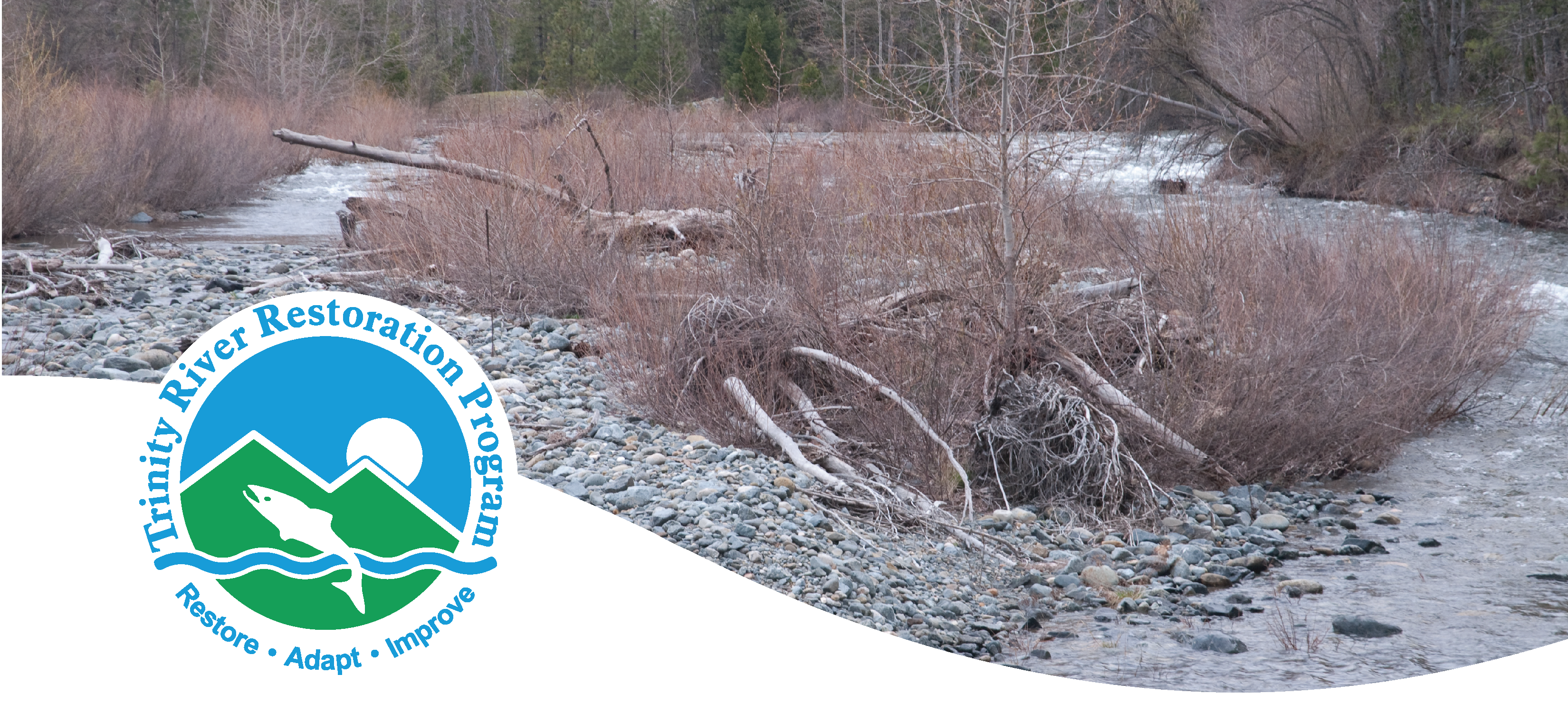
River Riffle Newsletter – February
Contents
- Current Conditions
- Implementation Branch: Proposed Restoration Activities
- Featured Article: Sediment, the Building Blocks of the Trinity River
- Trinity River Watershed Animal Spotlight: Freshwater Mussels in the Trinity River
- Upcoming Meetings and Events
What we’re reading/watching
Green Sturgeon aren’t Salmon: Updated life cycle models for management
Over 65 million years ago, as Tyrannosaurus rex roamed the great plains, green sturgeon (Acipenser medirostris) were already roaming the world’s waters. While these ancient fish survived the fall of dinosaurs, they are now in danger of extinction largely due to humans. (California Water Blog)
California Gov. Newsom pledges to remove dams to restore salmon runs
California Gov. Gavin Newsom on Tuesday released a plan to restore wild salmon habitat by removing or bypassing dams that block the migration of a keystone species for ecosystems and tribal communities. (Jan. 30) (AP Video: Terry Chea)
A Beautiful Mess – Improving Brook Trout Habitat in the Southeast – Trout Unlimited
Check out this video from Trout Unlimited who are helping streams recover from long ago logging practices in the Southern Appalachians by felling trees into streams. The woody structures are helping streams recover by providing needed cover for fish, as well as aiding the streams’ ability to be resilient to flooding and droughts.
Stage 0 Floodplain Restoration on the Lower South Fork McKenzie River – McKenzie Watershed Council
“Stage 0” refers to an approach to floodplain restoration that seeks to maximize the floodplain at all flow conditions by removing artificially placed sediments (i.e. berms, historic roadbeds, etc.). The Stage 0 design approach was also used by our partners the Yurok Tribe in constructing the first Stage 0 design in California at Indian Creek in 2021. The presentation given by Jared Weybright, McKenzie Watershed Council Executive Director, describes the South Fork Mckenzie river project’s which was an inspiration for the Yurok Design team.
Current Conditions
Scour
Scour is an important ecological function of rivers that occurs when winter rains and snowmelt grace the landscape. Scour is a term that refers to the pushing sediments in building a rivers landscape both ecologically and physically. Scour moves rocks, resets algae and macroinvertebrate populations and clears holding pools, all with the power of water.
For fish the timing of scour events is critically important. As flow calms, algae and eventually macroinvertebrates begin to colonize. As flows begin to rise, scour occurs dislodging algal and bug colonies into the drift providing food for hungry migrating juvenile salmon on their way to the ocean. If scour events do not occur (like near Lewiston Dam in the winter) bugs and algae are allowed to grow eventually becoming too large for the freshly emerged salmon to eat. Listen in as Dr. Eric Peterson, Vegetation Ecologist for the Trinity River Restoration Program explain this process.
2024 Water Year, thus far
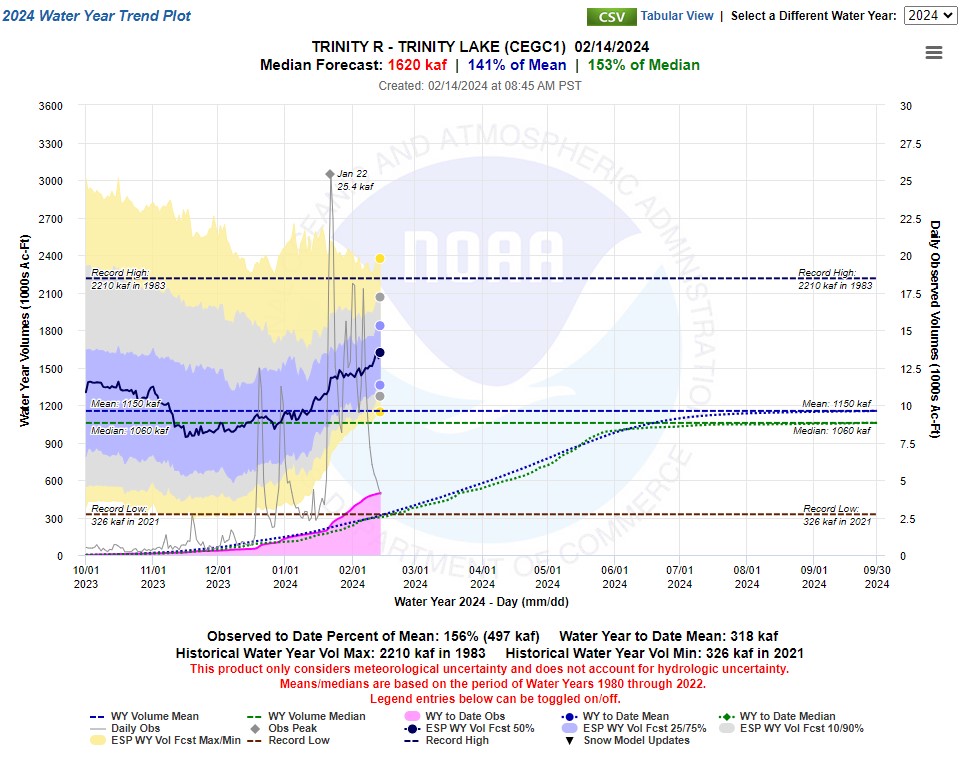
NOAA’s California Nevada River Forecast Center has a Water Year trend plot that tracks Trinity Lakes accumulation in real time and also predicts reservoir levels based on the current year’s trend which starts in October.
The California Department of Water Resources B-120 is an additional tool that utilizes human and station collected snow pack data from targeted areas within the Trinity Reservoir drainage. The B-120 reports are published around the 10th of the month in February, March, April and May. The April B-120 designation defines the water year type for the Trinity watershed and has only overpredicted the water year type once, in 2008.
Implementation Branch
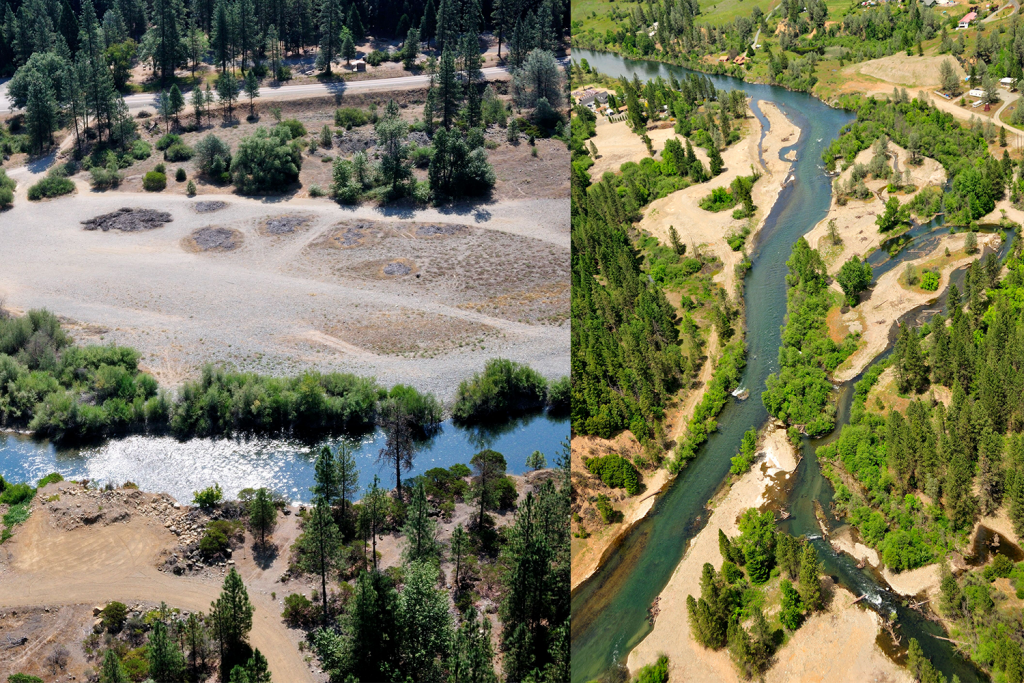
A draft environmental assessment (EA) will be released in the coming weeks for two proposed channel rehabilitation projects on the Trinity River, the Upper Conner Creek Rehabilitation Project in Junction City and the Sawmill Gravel Processing Site Project in Lewiston. The Implementation Branch and those involved in the projects will host an open house to discuss the proposed designs and restoration activities. See below in the Events Section for the details. We hope to see you there!
Featured Article
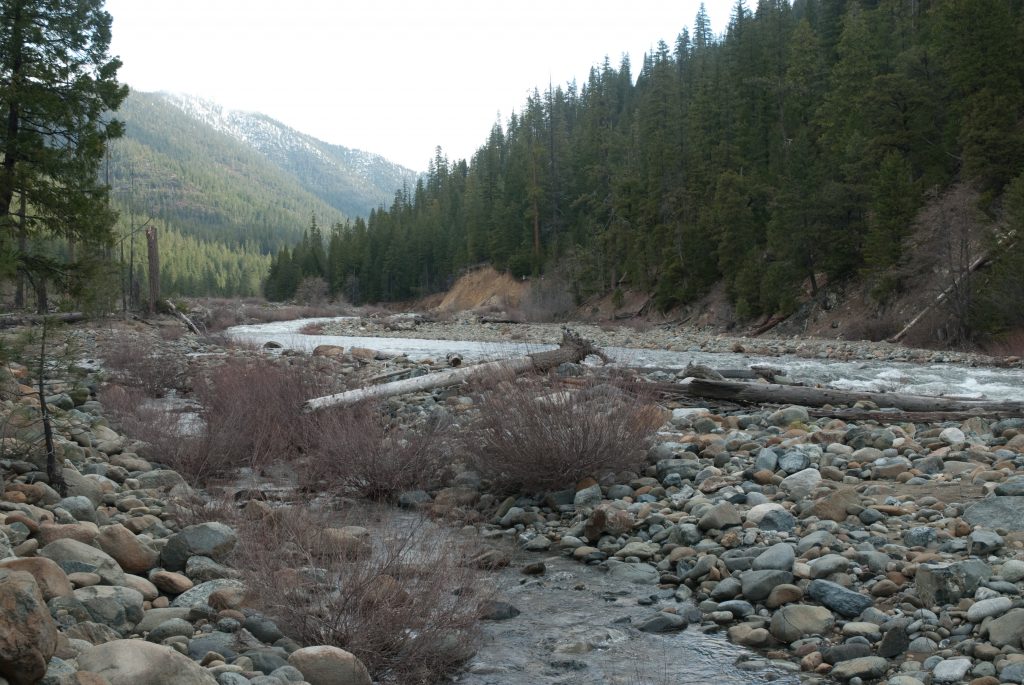
Sediment, the Building Blocks of the Trinity River
When you go down to the river, it’s hard to ignore the assortment of sediment on the bed and banks – from sand and silt, to gravel, to larger cobbles, to the largest of boulders. Seeing rocks that contrast so strongly with the rough, jagged ones in the surrounding hills might beg the question – how did these get here, where did they come from, and how long ago did they arrive?
Photo: Riparian area along the Trinity River above Trinity Reservoir showing an assortment of sediment, vegetation and large wood. [TRRP]
Trinity River Watershed: Animal Spotlight
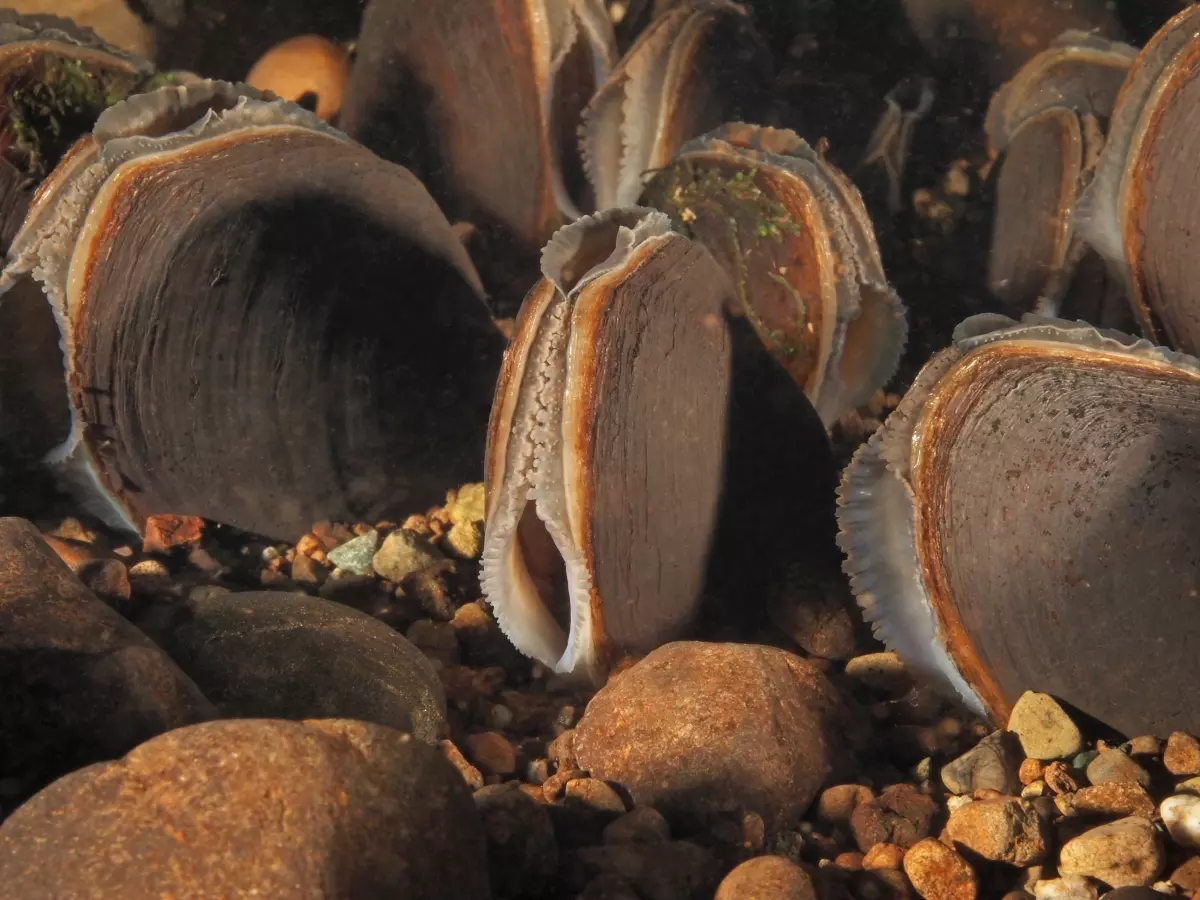
Freshwater Mussels in the Trinity River
Freshwater mussels are considered to be one of the most sensitive and threatened aquatic species within Northwestern watersheds. In North America, there are 297 known freshwater mussel species. Nearly three-quarters of these are considered imperiled, and more than 35 species have gone extinct in the last century and only eight species are known to exist west of the Continental Divide. Mussels have a fascinating life history strategy, which involves parasitizing on fish during their larval stage, and can live to be over 100 years old. They are considered an indicator species, like the good ole canary in a coal mine, as they require pristine water quality to thrive.
Photo Credit: Western pearlshell Mussel photo by Roger Tabor USFWS
Upcoming Meetings and Events
For a full list of events, click to view the TRRP Calendar.
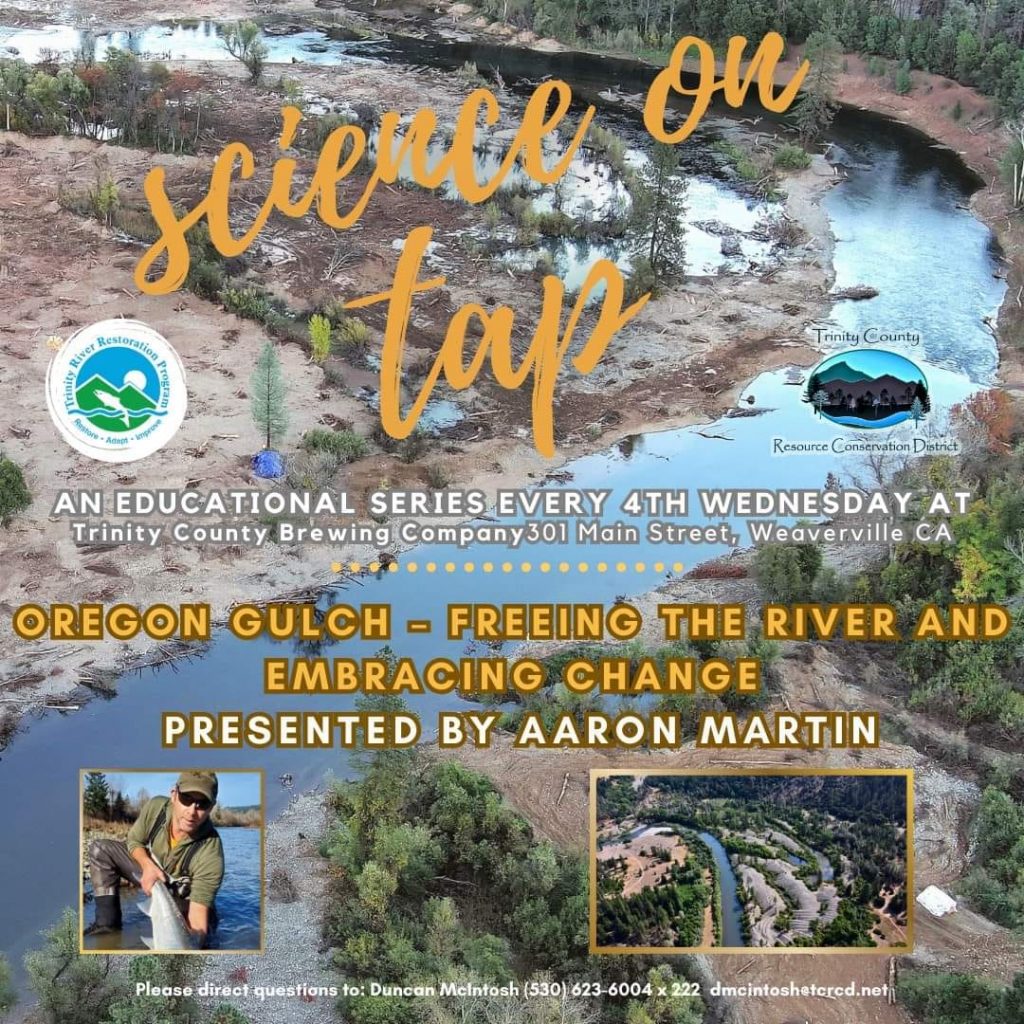
February 28, 6pm – Science on Tap
Trinity County Brewing Company
Join us and Aaron Martin, fisheries biologist from the Yurok Tribal Fisheries Program, who will present, “Oregon Gulch – Freeing the River and Embracing Change.” Aaron’s presentation aims to shed light on the complexities of river restoration and the necessity of adaptive approaches to river ecosystem conservation.
As the technical field manager and habitat specialist for the Yurok Tribe, Aaron Martin has made a notable impact on habitat restoration. His role includes innovative design planning and project implementation, which seek to address challenges, enhance aquatic habitats, and increase biodiversity.

March 19, 5-8pm – Open House
Save the Date!
Informational meeting for two proposed channel restoration sites
Junction City Elementary School
The Trinity River Restoration Program will host an Open House on Tuesday, March 19 from 5:00-8:00pm at the Junction City Elementary School. The event will feature information regarding two proposed rehabilitation sites, Upper Conner Creek located in Junction City and Sawmill Gravel Processing Site near Lewiston. Restorationists, designers, ecologists and the construction crew will be present to talk about restoration activities and answer questions regarding the two proposed projects.
Additionally, in honor of Junction City Elementary School, students will be showcasing an ecological art show for attendees featuring fish of the Trinity River. The art show is made possible by the amazing teaching and administrative staff of Junction City Elementary School, as well as the Trinity County Resource Conservation District.
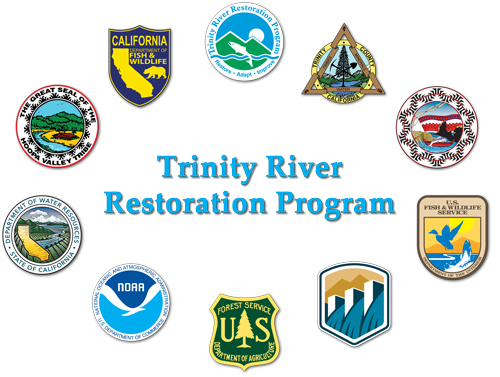
March 20 & 21, All Day – Quarterly TMC Meeting
In Person: Weaverville, Ca.
Virtual: Teams meeting call-in info on the agenda.
Click here to join the meeting
Meeting ID: 261 404 741 506
Passcode: gyLhfr
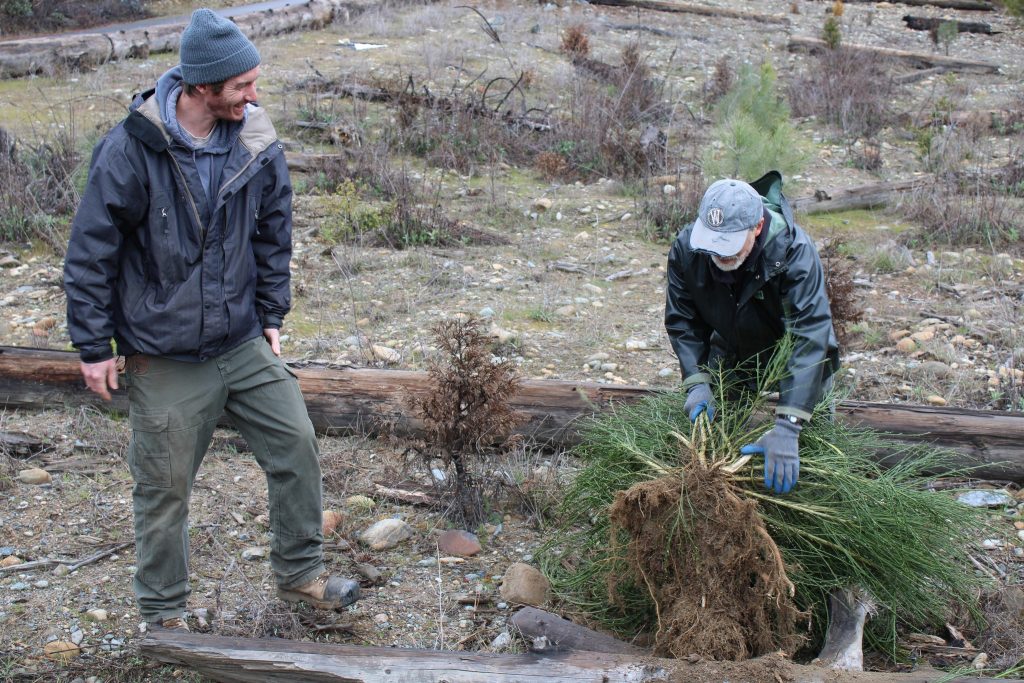
April 6, Volunteer Invasive Plant Pull – Save the Date!
Junction City, Ca.
An invasive plant pull volunteer event will be held at the Junction City Campground River Access and Restoration Site on Saturday, April 6 (time TBD)! Join the Trinity County Resource Conservation District (TCRCD), Trinity River Restoration Program, and Bureau of Land Management to help eradicate invasive Scotch and Spanish broom, making space for native plants and preventing the spread of these weeds in our watershed. Volunteers are encouraged to wear appropriate clothing for working outdoors, and to bring their own reusable water bottle. Water, snacks, tools, and gloves will be provided.
Contact Us
Call Us: 530-623-1800 Email Us: info@trrp.net
